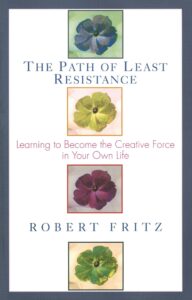
Question More, Action Knowledge.
Remember, at QMAK, we don’t just teach; we empower. We don’t just inform; we inspire. We don’t just question; we act. Become a Gold Member, and let’s unlock your child’s full potential, one question at a time.
 As homeschooling parents, one of the most valuable gifts we can give our children is the ability to tap into their innate creative potential and consciously shape their lives. Robert Fritz’s groundbreaking book, The Path of Least Resistance, offers invaluable insights into mastering the creative process and becoming the predominant creative force in one’s life.
As homeschooling parents, one of the most valuable gifts we can give our children is the ability to tap into their innate creative potential and consciously shape their lives. Robert Fritz’s groundbreaking book, The Path of Least Resistance, offers invaluable insights into mastering the creative process and becoming the predominant creative force in one’s life.
By incorporating these principles into our homeschooling approach, we can help our children develop the mindset and skills to create the lives they truly desire.
Fritz argues that our lives are shaped by underlying structures, such as our beliefs, assumptions, and patterns of thought. These structures create a path of least resistance that determines our behaviors and outcomes. To create the results we want, we must learn to consciously design structures that align with our goals and aspirations. This involves shifting from a reactive-responsive orientation, where we feel at the mercy of circumstances, to a creative orientation, where we take intentional action to bring our desired outcomes into being.
One of the key insights from The Path of Least Resistance is the power of vision. Fritz emphasizes the importance of having a clear, compelling picture of the results we want to create. By helping our children define their visions and goals, we empower them to focus their energy and actions in a purposeful direction. Encourage your homeschooler to dream big and imagine the possibilities, without being constrained by current limitations.
Another crucial principle is the concept of structural tension. This refers to the gap between our current reality and our desired outcomes. As Fritz explains, “Structural tension is formed by two major components: a vision of the result you want to create and a clear view of the reality you now have.” By learning to hold this tension and stay focused on their visions, our children can generate the creative energy and momentum needed to overcome obstacles and achieve their goals.
To support our children in navigating the creative process, we must also help them develop an empowering relationship with current reality. Fritz stresses the importance of accurately assessing and acknowledging the truth of our current circumstances, without judgment or resistance. By teaching our children to embrace reality as a source of valuable feedback and learning opportunities, we help them cultivate the resilience and adaptability needed to thrive in the face of challenges.
Throughout the creative journey, our children will inevitably encounter setbacks and failures. Fritz encourages us to reframe these experiences as essential parts of the learning process. By helping our children view “failures” as opportunities for growth and adjustment, we foster a growth mindset and a willingness to take risks and experiment. Celebrate their efforts and progress, and model the importance of perseverance and self-compassion.
As our children learn to think and act as creators, they will naturally begin to make more conscious, fundamental choices aligned with their values and aspirations. Fritz emphasizes that our power to choose our thoughts, attitudes, and actions is always available to us, even in the face of difficult circumstances. By empowering our children to take responsibility for their choices and align them with their visions, we help them develop self-awareness, integrity, and a deep sense of purpose.
Ultimately, by integrating these principles from The Path of Least Resistance into our homeschooling approach, we empower our children to become proactive, purposeful creators of their life experiences. As they learn to define compelling visions, navigate structural tension, embrace current reality, learn from setbacks, and make conscious choices, they develop the creative capacity to build deeply fulfilling lives aligned with their unique gifts and values.
With these skills and mindsets, our children will be equipped to face life’s challenges with confidence, resilience, and a profound sense of purpose.

Remember, at QMAK, we don’t just teach; we empower. We don’t just inform; we inspire. We don’t just question; we act. Become a Gold Member, and let’s unlock your child’s full potential, one question at a time.